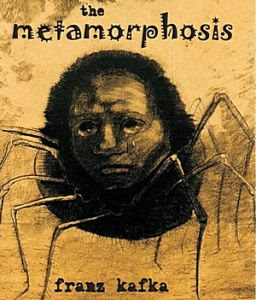Battle of the ‘Beasts’
dc113507 on Apr 4th 2012

Have you ever wondered what it would be like to wake up one day transformed into a beast, a monster, or some sort of alien creature, completely isolated and repulsed by society? The answer to this question is most likely no you have not. In all honesty, the fantastic nature of the question is so bizarre, why would someone, in their daily routine even consider it? Perhaps even the notion of this occurring makes us too uncomfortable to contemplate it.
When I read Franz Kafka’s ‘The Metamorphosis’ I instantly began to compare it to Mary Shelley’s novel ‘Frankenstein.’ Both stories are centered on a strange and foreign character. Both stories are so widely nonsensical that it begs the question, why decades after they were written are these fantastical texts still read and analyzed by English students and scholars alike? Both Kafka and Shelley use the central image of their story to convey a serious theme regarding the effects isolation and rejection by society can have on a person, or in these cases a creature.
The characterization of both Gregor as an insect and the monster as a gigantic hideous creature are key to the illustration of the themes both authors in respective texts try to convey. The characters in these stories are isolated and secluded from society. Gregor’s transformation in the beginning of the story dismantles any relationships he had previously had with his family or coworkers. He is now kept in complete seclusion in his bedroom, hidden from the outside world. His previous life as he knew it is now a part of his past. Not only is Gregor denied the luxury of living life through his daily routine, but his family now begins to resent him. As the story goes on everyone in the household begins to care less and less about the state of Gregor’s health. Their sympathy diminishes and Gregor seems to be trapped in his home in a state on estrangement. Gregor’s family seems to realize their sympathy as limits,and the stress of Gregor’s state wears on them emotionally.
Similarly the representations of the grotesque monster as a central character in Mary Shelley’s novel ‘Frankenstein’ aims to convey the mental and emotional effects placed on someone’s life when they are forced to become an outcast in society. The novel centers around Victor Frankenstein’s creation of the morbid and horrendous monster. The monsters terrifies everyone it comes into contact with and it is forced to exist in complete seclusion and solitude.His rejection by society causes him to endure emotional grief and he consequently becomes violent and unhinged. These effects cause the reader to see, albeit in a fabricated manner, the detrimental effects loneliness and isolation can have on someone, or in this case something’s life.
Perhaps readers are uncomfortable with the fantastical nature of the texts and unrealistic characters of the novel. But maybe readers are uncomfortable with the critical statements made in these stories regarding society’s conduct towards outcasts.I think these texts read in a modern day society force a reader to evaluate his or her daily behavior. This self evaluation is not necessarily something we are always comfortable with doing.
How quick are we to form judgements on a person based on their physical appearance, material drapings, or perceived social standing? How quick are we to make harsh judgements on someone and deem them outcasts or taboo members of society? Although we won’t be eager to fess up, the answer to this question is probably far too quickly. Our society is filled with people who suffer from addictions, illnesses, physical deformities and mental conditions that make them different from your average John Smith and Mary Jane. We are so quick in placing these people in a category that demeans their humanity and insults their dignity. We isolate these people with no regards to their emotions and mental well being. A second thought is never given to the lack of compassion and neglect we show these outcasts.
Authors like Shelley and Kafka write with a purpose. They use such bold plot lines and outlandish characters to gain a firm grasp on the attention of their readers. I feel that they aim to get their readers to evaluate their behavior and actions in retrospect to the text. Okay, so maybe we aren’t faced with monsters, and family members turned insects everyday, but we are constantly faced with people who are different from us in some way. Maybe we don’t show enough compassion or empathy to others, or maybe we don’t even give people a chance to show us who they are. Going to college in one of the most diverse schools in the nation, we can take a lot away from the themes shown in these literary texts. Hard as it may be to admit, these works can force many of us to recognize the need for an attitude and behavioral adjustment in our lives.

Filed in Uncategorized | 27 responses so far